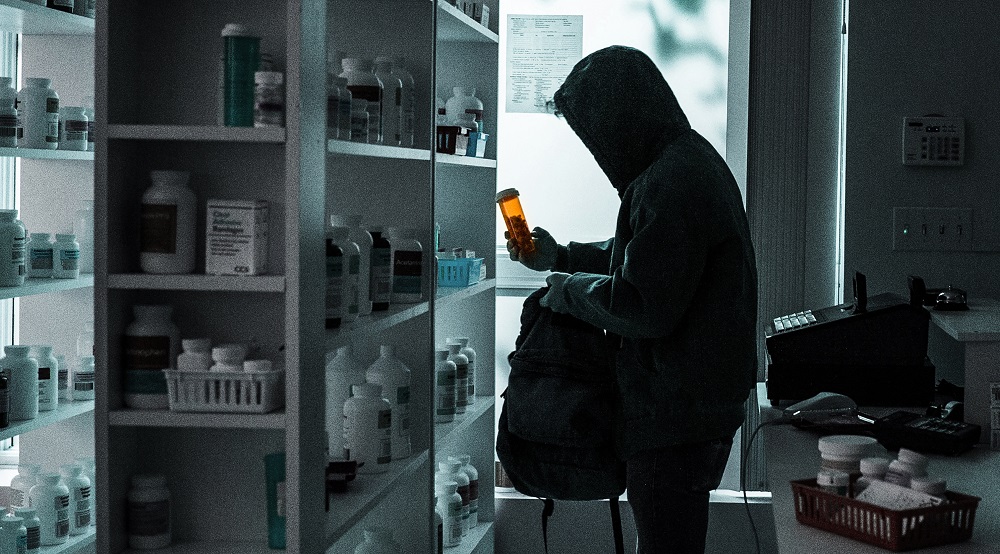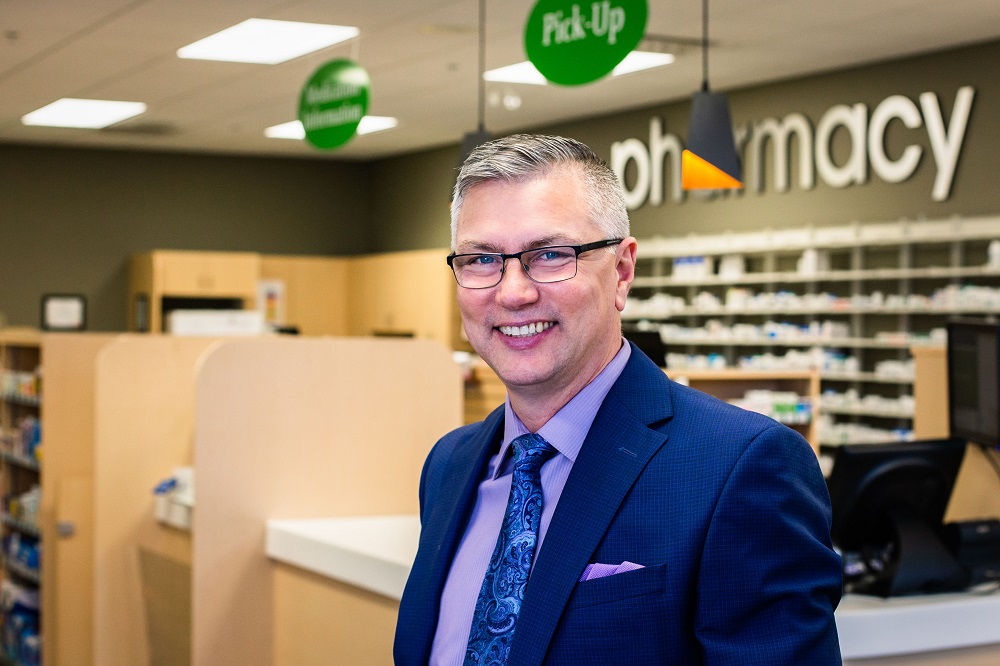By Michael Mui
Communications Manager, BCPhA
It can happen like this: a masked man pushes the pharmacy doors open. He raises a gun in his hand while approaching the pharmacy counter, ordering staff to put their hands up and unlock the safe.
The man shouts a command while demanding narcotics.
“I will shoot you if you touch the alarm. I will shoot you if you don’t get on the ground. I will shoot you if you don’t put your hands in the air.”
In this instance, the pharmacy staff filled a bag with drugs, which the man grabs before fleeing out the rear entrance of the busy Vancouver store. The suspect was later arrested and received 26 months in prison. It was the 16th time the repeat offender had been convicted of a crime.
While pharmacy robberies in British Columbia have significantly dropped off since enhanced security measures were adopted by the College of Pharmacists of British Columbia in 2015, pharmacies remain occasional targets of crime. Just earlier this year, the Association received an increased number of queries from members about robberies in pharmacies. To assist members, the Association distributed an Issue Update notice which outlined available supports in addition to requirements for reporting to the College and to Health Canada.

As a community pharmacist, the possibility of crime impacting the pharmacy and its staff can be a very real concern.
Greg Wheeler, Board Director at the BC Pharmacy Association and owner of three pharmacies in Oliver, Penticton and West Kelowna, knows what it’s like to have his businesses targeted for crime. Most recently, in May 2021, his pharmacy in Oliver was broken into during the night and set on fire, resulting in $400,000 of damage.
“It’s a 4,000 square foot unit, the smoke damage affected everything. All our inventory, the shelving, the countertops, the ceiling, the tiles, the floor, it was stripped down to nothing,” Wheeler said.
“We felt like we were on an island by ourselves at that point, for sure. There was no real professional consultant to deal with.”
The damage was bad enough his store had to be reconstructed with plywood using a tunnel to connect a fully enclosed pharmacy and front till area for months to keep the pharmacy operating. This wasn’t his only brush with crime.
“Most of it, the impactful stuff, happens overnight when nobody is there. We’ve had people break through the front doors, break into safes and even attempt to steal the whole safe. And then I’ve had a couple of incidents over the years with my staff where it’s been more, potentially, violent,” Wheeler said.
“We had a guy come into the store, he was casing the place and waited for the second employee to leave. Then he came right into the dispensary, through the door, threatened that he had a weapon and demanded the contents of the safe. Another pharmacist, who worked for me, was doing a locum at the pharmacy down the road and was held up at gunpoint during the day.”
Deterrence
As a community pharmacist, the possibility of crime impacting the pharmacy and its staff can be a very real concern. The addition of the new security measures a few years ago were Canada’s first of their kind, and made as a direct response to deter robbery, after incidents of pharmacy robberies skyrocketed in the early 2010s. The targets of the robberies were often narcotics.
Today’s required security measures at pharmacies include mandatory time-delay safes, security cameras, motion sensors, monitored alarms, and signage that communicates the security measures and that there are limited targeted drugs on site.
Pharmacy teams, however, may choose to enhance their security beyond what is required. This often starts with visible deterrence. It could be signage, visible from the outside, that mention the presence of security cameras or alarms, or even opting to install metal gates or fencing along the pharmacy storefront.
“In our case, during the nighttime break-in, the suspect basically threw a rock through the window, reached in and flipped the lock-switch to open the door,” Wheeler said. “We took a lesson from that and ended up replacing all the windows in the front with a new type of glass that doesn’t break easily. Additionally, we checked with our local bylaws and fire department and replaced the front door locks with something that required a key to unlock, to eliminate the possibility of someone breaking the window and just reaching in to undo the lock.”
During business hours when staff are present, it can be prudent to speak with staff members to ensure they are aware of the proper security procedures. Considerations might include making sure there are multiple staff on site for shifts, or if there is only one staff member on shift, placing that person’s workstation near the alarm system so it can be accessed quickly in an emergency, and ensuring that the barrier between the dispensary and the front of store is always closed.
“The key is keeping it front of mind for your employees and having regular discussions so employees understand why policies and procedures are in place,” Wheeler said. “When our store was robbed in West Kelowna, our pharmacist was by himself because their colleague had left for a break. As soon as the patient (robber) came to the door, he moved away from his computer to greet the patient at the till — which ultimately moved him away from the silent alarm. That was a big learning point for all of us.”
During the Incident
Authored by a Toronto Police Service detective and a College pharmacist, a 2009 publication from the Ontario College of Pharmacists issued a series of bullet points for pharmacy staff should keep in mind during a robbery.
- Remain calm
- Do not try to be a hero
- Obey the robber’s commands
- Do not antagonize the robber
- Consider all firearms to be loaded
- Observe: age, weight, clothing, tattoos, scars, accents, hair colour and length; note the weapon; remember the direction the robber took to leave; try to note a vehicle licence plate number if available and write it down
Wheeler has similar advice for his employees.
“Don’t be a hero. Be aware of your surroundings. Be aware of who you are dealing with. Take note of those details, height, clothing, whatever else,” he said. “Do not do anything to aggravate or escalate the situation and give them what they want. Once they leave the store, lock the door and make sure it is safe. That’s what everybody’s taught.”
After the Incident
Pharmacies are required to report all security incidents to the College of Pharmacists of BC within 24 hours of the incident. A helpful Armed Robbery Questionnaire template is available at the College and can be used as part of the report.
Information in the report should include your PharmaCare code, pharmacy name and address, date and time of the incident, details of any drugs taken including DIN, description and quantity, along with details and description of the suspects. The report should be emailed to complaints@bcpharmacists.org or by fax to (604) 733-2493 or 1 (800) 377-8129.
Pharmacists must also report to Health Canada of the loss or theft of controlled substances or precursors using the Health Canada E-Services Portal or by submitting a Loss or Theft Report form via email. Within 10 days, pharmacies must also provide the form submitted to Health Canada to the College.
“One of the things we really looked at also was our employee benefit plans. We asked ourselves: what is available to our staff as far as their needs after an incident, such as counselling services,” Wheeler said. “We also made sure they felt supported, that our employees who were affected had time off if they needed it.”
The BC Pharmacy Association also provides a Pharmassist program as a benefit for Corporate members and their staff. The service includes three one-hour counselling sessions and can be accessed by contacting info@bcpharmacy.ca.
Getting Back to Business
Depending on the number of staff that the incident affected and the amount of losses incurred, a pharmacy may not be ready to immediately resume regular operations after a robbery or burglary incident.
In Wheeler’s example, the damage from the 2021 break-in and arson was so extensive that initially, it was estimated by the insurance adjuster that his store would be closed for half a year. The insurance reimbursement for the losses took eight months to arrive. It was only due to a good relationship with the pharmacy’s creditor that he was able to keep the store operating.
“We had to go through our whole inventory and price everything that we were missing, put a massive order in our wholesaler, and that took a good week or two to get done,” Wheeler said.
“At the time, we didn’t know if the burglary and arson was a vindictive move towards the pharmacy. Was there somebody we had made angry? We wanted to make sure our staff would be safe, so we identified the person’s face on the surveillance footage with the police and determined that it wasn’t one of our clients and no one on staff had any direct relationship or confrontation with him.”
When staff had to take time off following an incident, Wheeler was fortunate enough that he or his business partner could often step in to fill the gaps. Pharmacists who are unable to bring on extra staff may wish to reach out to other pharmacies within their community for assistance.
“Reaching out to somebody with experience in this area, who has been through it, connecting with these people to help work you through the process, of dealing with insurance companies, dealing with a criminal investigation, dealing with the inventory, and dealing with the health and welfare your staff after one of these incidents, that could be very helpful after something like this,” Wheeler said.

Greg Wheeler is a BC Pharmacy Association Board Director and the owner of three pharmacies under the Pharmacy Brands Canada banner, Oliver Pharmacy, City Centre Pharmacy and Rose Valley Pharmacy located in Oliver, Penticton and West Kelowna, respectively. He can be reached at gregwheeler@shaw.ca.
